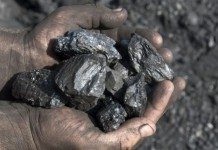
[miningmx.com] — NEW entrants to South Africa’s coal sector had a bucket of cold water thrown over them at the Coaltrans South Africa conference held recently in Johannesburg. A number of harsh realities were spelt out – in particular during the presentation given by Ian Hall, who is chair of the South African Coal Road Map Steering Committee – while others became apparent when you “connected the dots’.
The key problem area is the continued restriction to access to the export market, where Transnet Freight Rail (TFR) is still underperforming badly despite claims made at the conference by Transnet GM Divyesh Kalan that it “had turned the corner in 2010/2011′.
The other significant piece of bad news concerned uncertainty about expanding rail access to the Waterberg, where a number of junior coal companies have invested in projects.
The long-term future of SA’s coal industry rests on the Waterberg, which is slated to become the dominant producing coalfield once the existing main resources around Witbank and Middelburg are mined out. But achieving that will require construction of a heavy-haul railway line linking the Waterberg to Witbank. And it became clear at the conference that Eskom, for one, doesn’t seem so sure that’s going to happen.
If that line isn’t built – or if there are lengthy delays in its construction – it would be bad news for the development plans of companies such as ASX- and JSE-listed Resources Generation, ASX- and JSE-listed Firestone Energy and newcomer Namane Energy, which plans to list on the JSE next month.
Construction of that line is deemed vital to bring Waterberg coal to supply various Eskom power stations in Mpumalanga and so keep them running after coal currently available around Witbank/Middelburg runs out. The line would also link into the existing Witbank/Richards Bay line, allowing Waterberg coal to be exported through the Richards Bay Coal Terminal (RBCT).
So Hall’s gloomy assessment of the state of SA’s coal sector under the Integrated Resource Plan 2010 (IRP2) – which has been accepted by Government as a blueprint for meeting the country’s energy requirements through to 2030 – has to be viewed as a “wake-up call’ for investors.
Hall described the IRP2 plan as “a pretty grim scenario if you’re a coal producer’. It calls for huge investments in nuclear and renewable sources of energy and downplays the role of coal. Hall reckons if the IRP2 is implemented as planned then coal reserves in the Waterberg, Soutpansberg and Limpopo fields will remain largely undeveloped because there will be no further significant investment in SA’s coal industry.
Hall also says there will be no need for any major expansion of SA’s rail infrastructure. Hall comments: “Eskom would secure its coal requirements from the Central Basin (the coalfields around Witbank and Middelburg) through having restrictions imposed on coal exports.’
Answering a question from the floor about the reason for Eskom’s lobbying for controls on coal exports, Hall replied the State utility was working on the assumption its stations would only be able to source coal from the Central Basin. He added: “If you assume there’s going to be no further infrastructural development – in that the railway lines required to bring coal to the power stations in Mpumalanga from the Waterberg will not be built – then Eskom is correct. They probably will run out of the low-grade coal they need, which is why they want to limit exports.’
Speaking after Hall at the conference was Eskom chief commercial officer Dan Marokane. Asked for his reaction to Hall’s gloomy scenario, Marokane listed a string of risk factors that could affect future coal supply from the new regions. These included 1,2bn t of coal that Eskom viewed as being “at risk to project delays between now and 2039′. He also cited infrastructural challenges, such as the supply of sufficient water to the planned new coal mines in the Waterberg and the need for a heavy haul coal line from the Waterberg to Witbank. Marokane estimated that line would cost between R10bn and R40bn to build, depending on railage volume requirements.
He repeated Eskom’s stance that the utility didn’t want to block coal exports but felt there had to be a balance between the supply requirements of the domestic and export markets.
Of course, limiting coal exports would be very bad news for investment into SA’s coal sector, but TFR is already doing a good job of limiting coal exports through its current inability to rail coal. The RBCT now has the capacity to export 91m t of coal a year. Transnet’s current budget provides for the provision of 81m t/year of railage capacity by 2015/2016. However, TFR only managed to deliver 63,4m t to the RBCT during calendar 2010 and by end-May this year was running at an annualised level of just 61m t.
Despite that Kalan says TFR will rail 73m t of coal in its financial year to end-March 2012 and will do so by railing at an average rate of 6,4m t/month from June until then. However, TFR has only come close to that target twice in the past 12 months, when it managed to export 6m t in June and 6,1m t in September last year. The monthly average so far this year is just 5,1mt.
RBCT CEO Raymond Chirwa clearly doesn’t believe Kalan because the terminal has chopped its forecast exports for calendar 2011 from its original estimate of 70m t to 63,4m t. And a coal industry source described TFR’s forecast as “a pipedream’.
Now throw in TFR’s apparent plans to allocate preferential treatment on export railages to empowerment coal juniors at the expense of the other members of the RBCT.
Kalan told the conference TFR was working on a strategy to “unlock some capacity on the Richards Bay corridor’ for the juniors but wouldn’t provide details. Asked if that meant penalising other exporters – given TFR’s inability to shift the coal at the required rates – Kalan replied: “That’s a good question. I’m afraid I cannot say anything more at this stage.’
The only good news for the industry came from Hall in his assessment the IRP2 plan may have to be revised because its targets may not be met. He said: “There’s often a disconnect between policy and implementation – and it’s not just in SA where this happens. What I’m saying is that installing 17GW of renewable energy and 10GW of nuclear energy in SA by 2030 is a very tall order to deliver. You have to ask whether it’s going to happen. I can’t answer that question.’
If the IRP2 targets aren’t met the likely result will be to fall back on greater power generation using coal. Hall says that would “result in the development of the Waterberg and Soutpansberg fields, the construction of more multi-product mines and the expansion of rail infrastructure. That’s a win-win for the coal industry and the country. It will allow generation of power at the cheapest cost as well as an increase in coal exports.’
– Finweek











